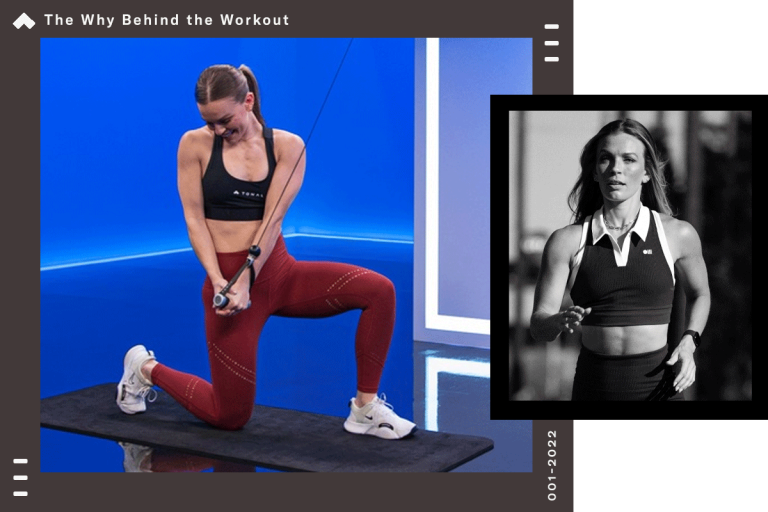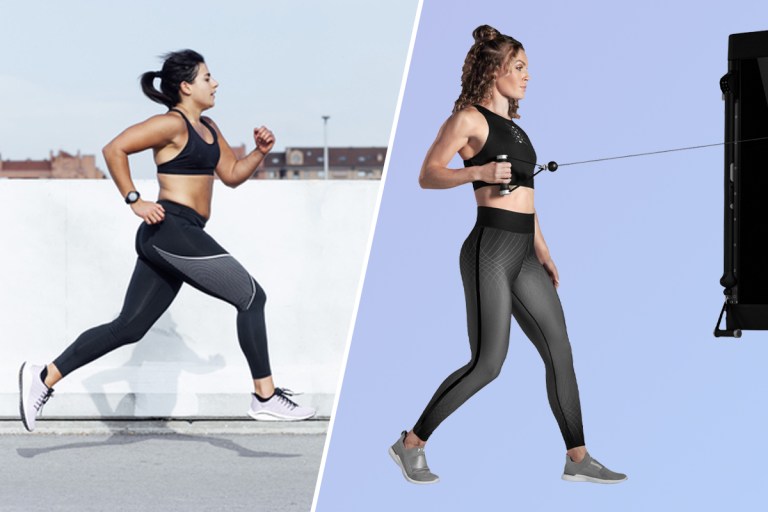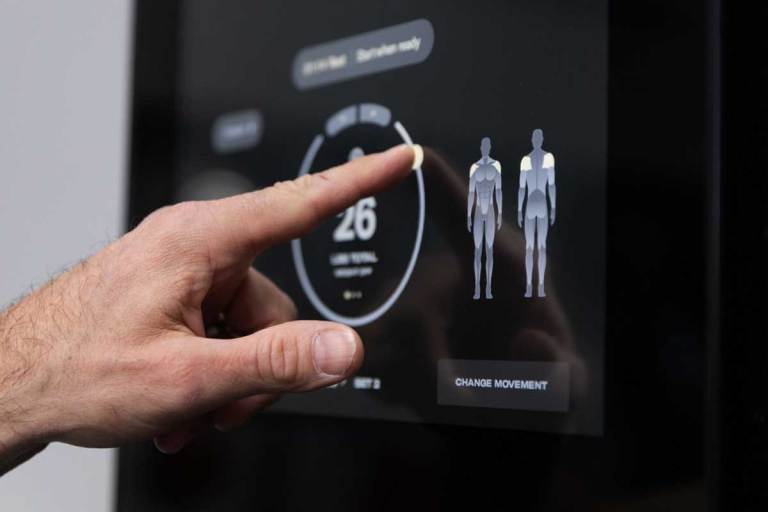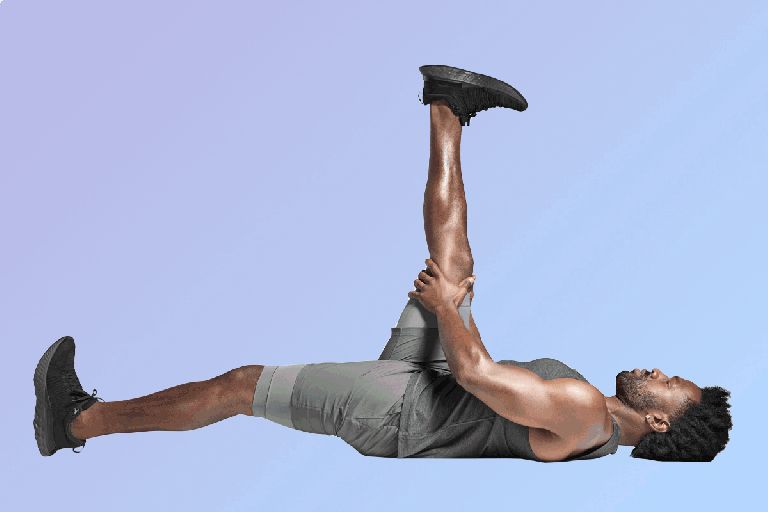Marathon Training? How to Build Strength to Improve Your Running
Resistance training can help you run faster, avoid injuries, and feel strong mile after mile.
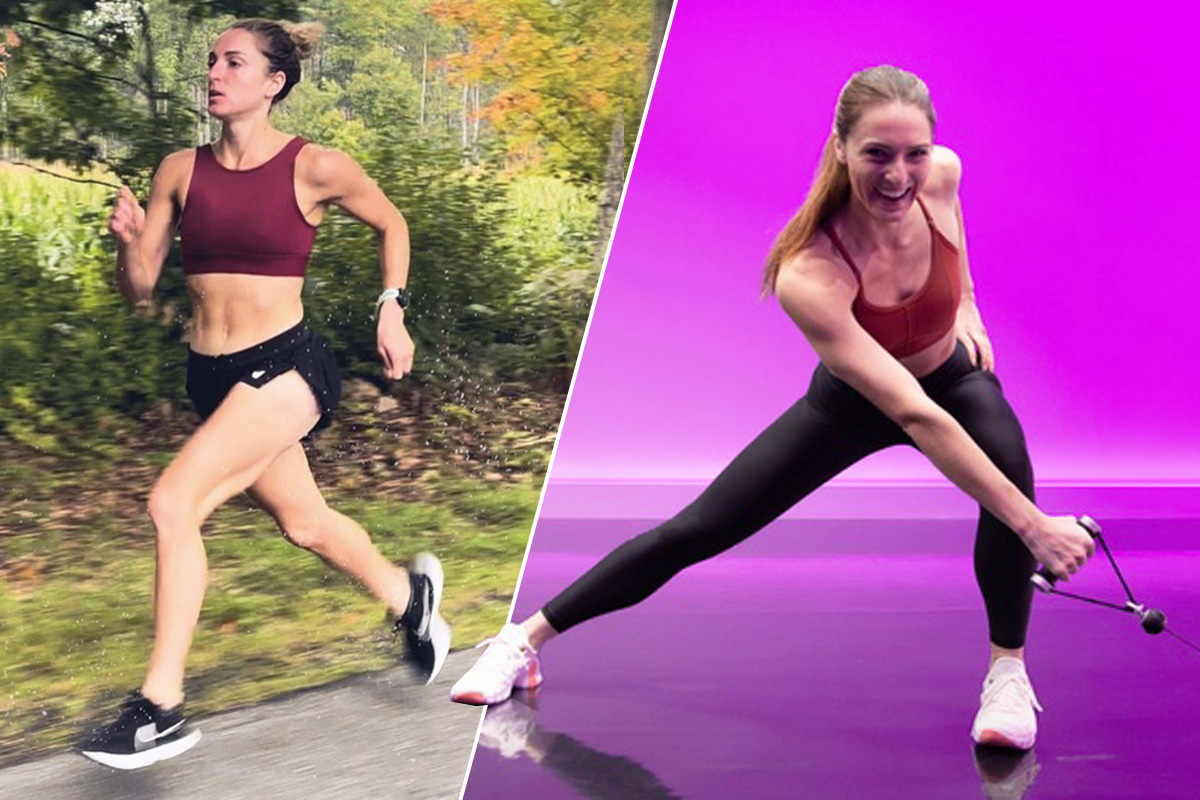
When you’re planning on running a marathon, you can probably expect to run lots (and lots) of miles in preparation for tackling those 26.2 miles on race day. But if you want to finish feeling strong, you can’t forget about strength training.
“Runners, notoriously, just like to run,” says Kristina Centenari, a Tonal coach, certified personal trainer, and marathoner. But lifting primes your muscles, tendons, and ligaments to better absorb impact and maintain your running form. In fact, strength training cut the risk of overuse injuries nearly in half among athletes, according to one scientific review. By prepping your body for the impact of logging hundreds of miles on the roads or trails as you train for your marathon, you’re more likely to make it to the starting line injury-free.
Besides keeping you healthy so you can continue running, strength training may actually make you a faster and more powerful runner. A combination of strength training and plyometrics improved running economy and performance among trained endurance runners, a 2022 meta-analysis showed. Whether you’re looking to shave a few minutes off your marathon time for a new personal best or just want to feel strong every step of the way, strength training is key.
During marathon training, though, running should be your main focus while lifting plays a supporting role—you don’t want to be too sore to get in your miles. “Don’t go overboard,” says Centenari. “Make sure that you’re focused on your strength training, but not leaving your sessions feeling absolutely dead. We don’t want to overdo it.”
Just as you’d train differently for a marathon than you would for a 5K, your strength training in the months leading up to your marathon will look different than how you’d lift if your goal was maximizing strength or hypertrophy. Here, Centenari breaks down everything you need to know about strength training for your best marathon ever.
How Often Should You Lift During Marathon Training?
The amount of time you spend lifting during your marathon training will depend on your previous strength training experience, your specific goals, and any particular injuries you may be dealing with or trying to prevent.
As a general rule, though, Centenari recommends strength training for half the number of days that you run each week. For example, if you’re running four times per week, aim for two lifting sessions. Running six days a week? Increase that to three strength training days. “It’s a good goal because a lot of times with busy schedules, people are going to prioritize running, but if you have that ceiling as a goal, you’re more likely to do it,” says Centenari.
That doesn’t mean you need to lift heavy each day, though. You can split your time between 1-2 days of heavy resistance training and 1-2 days of mobility work depending on where you are in your marathon training cycle and how fatigued you’re feeling from your weekly runs.
With multiple runs and strength training sessions each week, you’ll likely need to double up and do both on the same day, especially if you want to dedicate a full day each week to rest and recovery. When you’re lifting and running on the same day, Centenari recommends running first if your training plan calls for a long run, tempo run, or interval workout so your legs are fresh for your run.
On easy running days, she recommends lifting first so you can give more energy to your strength training. It’s okay if your legs are tired on an easy run day—in fact, this might encourage you to keep your heart rate low and not push the pace, and it trains your body to run with some degree of fatigue, which you’ll definitely be feeling in the later miles of the marathon.
How Should You Align Your Lifting with Your Marathon Training?
A standard 12-18 week marathon training plan will typically include three phases: a base-building phase dedicated to gaining aerobic endurance; a peak phase that includes your highest volume weeks, longest long runs, and workouts including tempo runs, intervals, or marathon-pace work; and a taper phase during which your mileage decreases and you focus on recovery and feeling fresh on race day.
Since your runs and goals differ in each phase, you’ll want to change up your strength training as well to best support the intention of each phase.
Phase One: Base (4-8 weeks)
To run 26.2 miles, you need a strong aerobic base. This first phase of marathon training is devoted to building that base through high-mileage running, typically at a low to moderate intensity level. Your plan may include some faster running during this phase to practice recruiting your fast-twitch muscles, but you’ll mostly be logging lots of slow and steady miles.
As for what your strength training should look like during this phase, Centenari recommends focusing on unilateral (or single-leg) movements to improve balance and stability and eliminate any imbalances that could lead to running injuries over time. She suggests lifting higher volume, in the 8-12 rep range during the base phase.
Phase Two: Peak (4-6 weeks)
During this time, it’s especially important to keep your hard days hard and your easy days easy. In other words, schedule your lifting sessions for later in the same day as your tempo or interval runs. That way, you’ll be fresh for your running workouts and have at least a full day in between for recovery.
“You’re going to be putting in enough volume on your feet to the point where you’ll want to take it down in strength sessions,” Centenari says of your lifting during this phase. She recommends lifting in the 4-6 rep range to concentrate on strength and power development. You’ll always benefit from including unilateral exercises in your routine, but Centenari suggests shifting your focus to heavier bilateral lifts at this point. This is also a good time to add in plyometrics to improve your power and explosiveness.
Depending on your specific marathon training plan, this phase may be broken down further into preparation, speed, and/or peak weeks. You can follow the same basic lifting principles during these weeks, but don’t hesitate to substitute a mobility session for a strength workout if your hard runs are leaving you feeling fatigued.
Peak Three: Taper (2-4 weeks)
By this point in your training, your longest long runs and hardest workouts are behind you. The goal now is to avoid injury and promote recovery so you can make it to the starting line feeling fresh. Your mileage will decrease from your peak during this week as you focus on maintaining your fitness.
Similarly, your lifting during this time should be all about maintaining your strength and power without shooting for massive gains and risking injury in the days leading up to your race. Keep up your bilateral lifts and plyometrics, but drop the volume and weight as you taper. If you’re lifting on Tonal, activate Recovery Mode to lower the resistance to a smaller percentage of your max. Centenari also recommends prioritizing mobility, so if you typically lift twice a week and do mobility work once a week, consider flipping that ratio during the taper.

What Strength Exercises Are Best for Marathon Training?
Centenari loves these moves for building strength, power, and stability for marathon runners. Try incorporating more unilateral exercises during the base phase; bilateral and plyometric moves as you peak; and upping the time you spend on mobility during your taper.
Single-Leg RDL

Why it Works: This move challenges your balance and stability while strengthening your hamstrings. Pay attention to how this move feels differently on each side to identify asymmetries between your two legs.
How to Do it: Lift your opposite leg straight back like you’re trying to kick the ceiling with your heel, dropping your upper body as the leg lifts. Imagine your torso is a barbell reaching from your heel to your head, keeping your body straight. Use the glute of the planted leg to power the torso back up and repeat on the same side.
Goblet Reverse Lunge
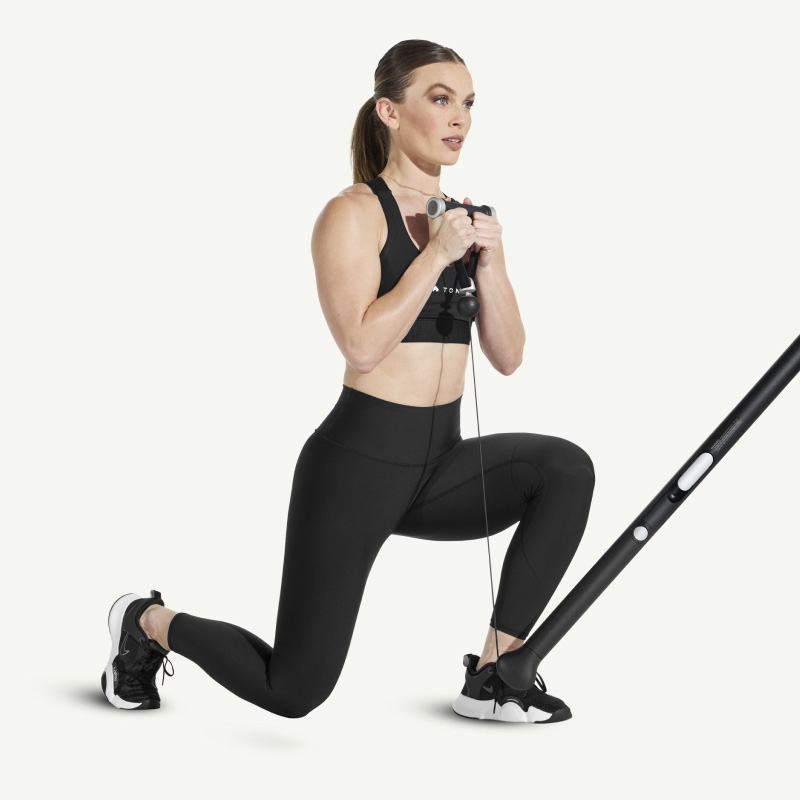
Why it Works: This is another unilateral exercise that works your glutes and quads while allowing you to practice loading one hip, which is essential for powerful running.
How to Do it: Hold the handle at the strap with thumbs wrapped around the top. Position it in front of your chest, and stand tall at the end of Tonal’s arm. Lower one leg behind you so that your knee just barely meets the mat, toes tucked on the floor, and try to create 90-degree angles with both knees. Push the floor away with the front leg to stand again, and repeat on the same side.
Resisted Lateral Lunge
Why it Works: “A lot of runners think they’re only moving forward and backward, AKA in the sagittal plane of motion, when they run, but it’s so important to work in that frontal plane as well,” says Centenari. This side-to-side movement builds lateral strength and trains your legs and glutes to absorb impact.
How to Do it: Take the handle in one hand and take a few large steps away from Tonal. Stand sideways so the handle is on the far side of your body with the cable crossing in front of you. Take a wide step toward Tonal and sit back into your inside leg like you’re sitting into a chair while keeping the other leg straight. Press the floor away from you with the inside leg and return to standing. Repeat on the same side.
Neutral Grip Deadlift
Why it Works: Deadlifts are an essential exercise for strengthening your entire posterior chain—especially your hamstrings—while promoting torso stability.
How to Do it: Place your feet hip-width apart, laces lined up with the end of Tonal’s arms. Bend your knees, hinge your hips back, and grab the handles. Press the floor away from you, pushing through your heels to stand tall. Keep your arms straight at your sides and your back as straight as a wall. Once at the top, keep your chest proud as you reach your hips back and return to the bottom position.
Goblet Squat

Why it Works: Load up this bilateral squat variation to develop strength and power in your legs and glutes.
How to Do it: Hold the handle strap with your thumbs wrapped around the top and position it in front of your chest. Stand with feet shoulder-width apart and toes slightly turned out. Reach your hips down and back like you’re sitting into a chair behind you. Push the floor away from you and stand tall powering the hips toward Tonal and repeat.
Jump Squat

Why it Works: Centenari recommends adding plyometrics to your training to help with power generation. Since you’re getting enough cardiovascular exercise from your running, don’t worry about moving at lightning speed or trying to squeeze in as many reps as possible. Instead, concentrate on generating power with each jump.
How to Do it: Squat down like you’re sitting into a chair behind you with your arms straight down toward your hips. Press the floor away from you through your heels to jump up while bringing your arms overhead. Land back in a squat position and repeat.
Skater Bound
Why it Works: Skater bounds also help with generating power and stimulating fast-twitch muscle fibers, and give you the added benefit of a lateral exercise.
How to Do it: Bound up and to the side off of one foot and land softly on the other foot, by shifting your weight back and down gently. Once you land, bound back to the other leg.
Pillar Bridge

Why it Works: Core strength is incredibly important for maintaining good running form, especially as you start fatiguing at the end of a long race. Centenari suggests including core moves, such as the pillar bridge, throughout your marathon training.
How to Do it: Get onto your mat facing the floor with both elbows under your shoulders and feet hip distance apart, toes tucked. Lift the knees to extend the legs and push the floor away from you through your elbows.
Lateral Bridge
Why it Works: Mix in a side plank to your core training to challenge your obliques.
How to Do it: Lie onto your side, place your elbow on the mat directly under your shoulder and stack your feet on top of one another. Lift the hips away from the floor to create a straight line from your head to your feet. Hold here, working the side of your body near the floor.
Bench Press

Why it Works: You can’t neglect your upper body when you’re marathon training. “You need your arms to run,” says Centenari. A compound push exercise like the bench press will give you a healthy dose of upper-body strength.
How to Do it: Lie on your back with your head near Tonal. Plant your feet on the floor, chest in line with the end of Tonal’s arms. Grab the handles and bring your arms straight over your chest. Lower down by bending the elbows about 45 degrees from the body with your forearm perpendicular to the floor. Press your knuckles straight up to the ceiling to finish with your hands above your chest.t
Single-Arm Bent Over Row

Why it Works: The pulling motion of a single-arm row mirrors the arm swing you do while running. Working your back in this exercise will assist with maintaining a strong running posture.
How to Do it: Grab the handle with one hand. On the same side, plant your leg firmly on the floor with a soft knee. Place your opposite limbs on the bench, hand under your shoulder, and knee under your hip. Using your back, imagine your shoulder blades sliding down to your hips, and pull the handle toward your torso with your palm facing your body. Release the weight forward again with control, and repeat on the same side.
90-90 Hip Stretch
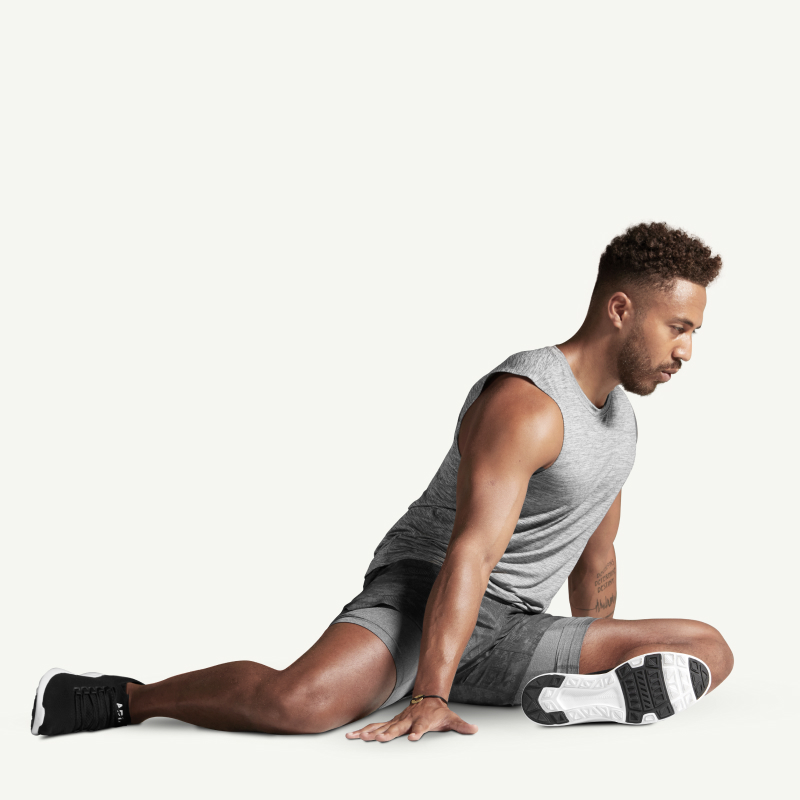
Why it Works: This stretch unlocks tight abductors, glutes, and hips, for better mobility while running.
How to Do it: Take a seat on your mat and create 90-degree angles with your front and back knees and hips. Bring your hands to the floor on each side of the front thigh. With a straight back, lean forward slightly opening your chest to your thigh to stretch the glute of the front leg. Slowly rise back up and repeat.
Cat-Cow
Why it Works: Improve mobility in your back with a stretch Centenari recommends for counteracting the strain running can put on your spine.
How to Do it: Start on all fours on your mat, knees under your hips and wrists under your shoulders, toes tucked. Inhale and open your chest, dropping the navel toward the floor and arching your back. Exhale and pull the navel toward the ceiling, pushing the floor away from you and pulling the shoulder blades apart as you tuck the hips.
Quadruped Hip Circle

Why it Works: This move isolates your hips as you move them through their full range of motion. It’s excellent for loosening up tight hips, which are very common among runners.
How to Do it: Start in a quadruped position with your hands under your shoulders, knees under your hips, and toes tucked. Maintaining a 90-degree angle with your thigh and shin, rotate your hip like a ball and socket, bringing your knee out and up until the heel faces the ceiling, then, lowering your leg to the floor. Reverse the movement and repeat on the same side.
